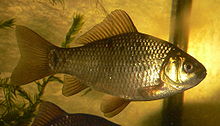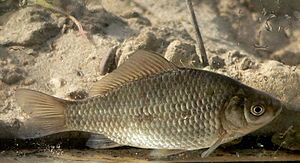- Crucian carp
-
Crucian carp Conservation status Scientific classification Kingdom: Animalia Phylum: Chordata Class: Actinopterygii Order: Cypriniformes Family: Cyprinidae Genus: Carassius Species: C. carassius Binomial name Carassius carassius
(Linnaeus, 1758)The crucian carp (Carassius carassius) is a member of the family Cyprinidae, which includes many other fish, such as the common carp, or the smaller minnows. They inhabit lakes, ponds, and slow-moving rivers throughout Europe and Asia. The crucian is a medium-sized cyprinid, which rarely exceeds a weight of over 3.3 pounds (1.5 kg).[citation needed] They usually have a dark green back, golden sides, and reddish fins, although other colour variations exist.
They are often caught as a sport fish: the British rod-caught record for largest crucian is four pounds, nine ounces, caught by Martin Bowler in a lake in southern England in 2003.[citation needed] There have been various bids for a breakage of this record since, but they have been passed off as the specimens have not been said to have been "true" crucians, but hybrids between the carp and one of its relatives,[citation needed] such as the goldfish, which are not native to the British Isles. In the Netherlands, a typical crucian specimen of 54 cm, weighing 3 kg has been caught and photographed.[2] Hybrids often exhibit hybrid vigour or heterosis, being much more adept at finding food and evading predators than either of their parents, and thus pose somewhat of a threat to the native carp population, and to other native aquatic animals.[citation needed]
These carp are also occasionally kept as freshwater aquarium fish, as well as in water gardens, although they are not commonly available commercially, mainly because they are not in particularly high demand due to the presence of more colourful fish such as the koi or orfe. However, they are one of the most important aquaculture species. In 2005, they were the species with the 10th highest production, globally.[3]
The variation in shape of a crucian carp can be very high. The fish get an almost perfect disc shape with well-rounded fins. If no predators such as pike or perch are present, the crucian carp will grow in length rather than height and the fish will be more slender-looking. The growth in height will make it difficult for predators to swallow the crucian carp.[4]
Contents
Relation to goldfish
Many sources will claim crucian carp are the wild form of the goldfish (Carassius auratus auratus), but the wild form of the goldfish is actually the Prussian carp Carassius gibelio , or sometimes Carassius auratus gibelio with gibelio identified as a subspecies of C. auratus. While they are certainly closely related, they are different species which can be identified by the following characteristics:
- C. auratus has a more pointed snout, while the snout of C. carassius is well rounded.
- The wild form of the goldfish C. auratus gibelio or C. gibelio often has a grey/greenish color, while crucian carps are always golden bronze.
- Juvenile crucian carp (and tench) have a black spot on the base of the tail which disappears with age. In C. auratus, this tail spot is never present.
- C. auratus have fewer than 31 scales along the lateral line, while crucian carp have 33 scales or more.[citation needed]
Use
Although the crucian carp (鯽魚) can be raised as pets, it is also farmed and commonly used in Chinese cuisine. Despite being reputedly bony, the fish is easy to raise and relatively cheap, so are often deep fried as part of a worker's meal.
There are many extensive and luxurious preparations for this fish in Chinese cuisine. For example, it can be found in the Shanghainese dish congshao jiyu (蔥燒鯽魚, lit. scallion-cooked crucian carp), which requires long hours for preparation since the fish needs to be soaked in vinegar, and then deep-fried, stewed for a long prolonged period, and cooled to make the fish tender enough to consume together with all its bones.[5] Also, crucian carp is used to make soup with tofu, which the Chinese believe to benefit women in the postpartum period.[citation needed]
References
- ^ J. Freyhof & M. Kottelat (1996). "Carassius carassius". IUCN Red List of Threatened Species. Version 3.1. International Union for Conservation of Nature. http://www.iucnredlist.org/apps/redlist/details/3849. Retrieved October 15, 2011.
- ^ http://www.visserslatijn.nl/specimenhunting/index.html
- ^ FAO 2005 - FAO Fishstats.
- ^ P. Anders Nilsson, Christer Brönmark & Lars B. Petterson (1995). "Benefits of a predator-induced morphology in crucian carp". Oecologia 104 (3): 291–296. JSTOR 4221109.
- ^ Lee, Jesse (2008), 上海味兒, 旗林文化, ISBN 978-986-6655-14-2
External links
- Fact sheet, taxonomic details, distribution maps, slideshow, and images of Carassius carassius at ZipcodeZoo.com.
- "Carassius carassius". Integrated Taxonomic Information System. http://www.itis.gov/servlet/SingleRpt/SingleRpt?search_topic=TSN&search_value=163352.
- Fish Holds Breath for Months
- How carp 'hold their breath' through winter - New Scientist
Principal commercial fishery species groups Wild Forage fishOther wild fishMolluscs- Sea cucumbers
- Sea urchin
- more...



Farmed Categories:- IUCN Red List least concern species
- Cyprininae
- Carp
- Invasive fish species
- Non-indigenous fish species in Ukraine
- Fish of Asia
- Commercial fish
- Animals described in 1758
Wikimedia Foundation. 2010.



